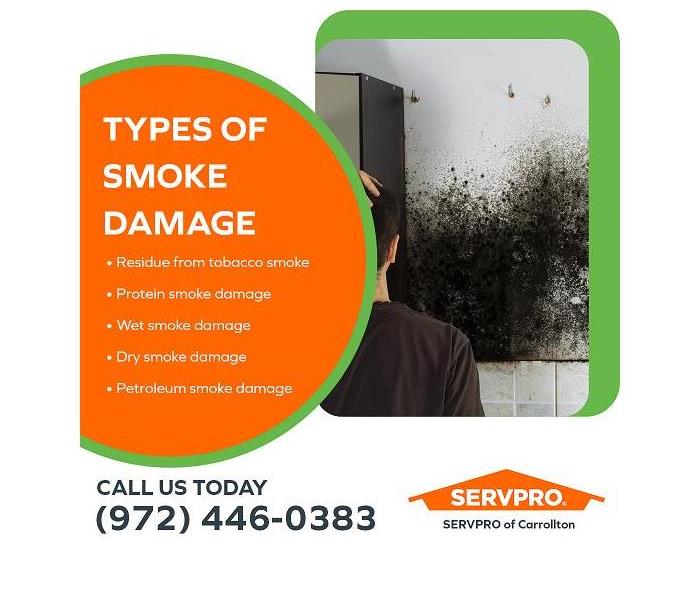Removing Odors Caused by Different Types of Smoke and Soot Damage in Dallas, TX, Homes
7/22/2022 (Permalink)
Blog Summary: The odor removal experts at SERVPRO of Carrollton explore the different types of smoke and soot damage left behind after fire damage.
SERVPRO of Carrollton understands that an important component of fire damage restoration is the removal of the odors caused by the different types of smoke and soot involved in fire damage disasters in Dallas, TX, homes.
Types of Smoke and Soot Damage
Damage restoration professionals distinguish between five types of smoke and soot generated by residential and commercial fires. Several factors determine what kind of smoke and soot a fire produces. These factors include:
- What fuels the fire
- The temperature of the fire
- How fast the fire is burning
Listed below is an overview of five types of smoke.
1. Residue from tobacco smoke
When people think of smoke and soot odors, they usually do so in the context of a fire damage disaster caused by cooking, a wiring malfunction, or an appliance failure. Yet, the most common type of smoke damage is from tobacco smoke from one or more occupants in a home or apartment. Marijuana smoke may also be a factor in some instances.
Damage from tobacco smoke involves unpleasant odors, as well as nicotine contamination on items and surfaces in the home. Remediation requires deep cleaning with the proper equipment and strong but safe cleaning and deodorizing products. Cleaning technicians must wear PPG such as gloves and goggles to prevent nicotine poisoning.
2. Protein smoke damage
Cooking fires are a leading cause of house fires in the US. Kitchen fires that involve the preparation of a meal involving beef, chicken, pork, or other forms of protein produce protein smoke damage. The burning food generates smoke that clings to wood and painted surfaces, leaving a yellowish-brown residue on whatever it touches. This residue can permanently discolor anything it comes in contact with. Protein-based smoke damage has the appearance of grease smeared on walls, countertops, and ceilings. Cleanup is challenging since the residue is greasy and has a strong, pungent odor. Fire damage cleanup professionals use special professional-grade cleaning chemicals that have been specifically formulated to address protein-based residue.
3. Wet smoke damage
Slow-burning, low-temperature fires, such as from smoldering rubber and plastic products, produce wet smoke. The low-flame combustion yields a strong, noxious, toxic smell, and the thick, black smoke produces sticky soot. Some smoke damage professionals consider wet smoke to be the hardest form of smoke damage to clean. The challenge for fire damage restoration specialists includes both the thick, sticky nature of the soot and the strong, acrid smell. Cleanup is time-consuming and costly.
4. Dry smoke damage
High temperature, fast-burning fires produce dry smoke with an extremely fine, powdery residue. This residue is easier to clean up because of its texture and composition. The fine, solid, dry soot is easily removed from flat, smooth surfaces. On the other hand, when the dust-like powder lights on a porous surface, it can become trapped in small holes and tiny craters on the surface or in the object. Extracting this type of soot from these protective enclaves is difficult. When the dry, powdery soot is disturbed, it can become airborne, and the particles can cause health effects.
5. Petroleum smoke damage
Smoke damage from the combustion of flammable petroleum products creates a darker smoke. The soot attaches to any and every type of material and is capable of staining surfaces. A grease-cutting solvent effectively cleans up petroleum smoke and soot damage.
Odor Removal Experts
A residential fire leaves behind toxic residue and pungent odors. The professionals at SERVPRO of Carrollton are trained to identify and eliminate the acrid odors that can cause health effects. The irritating and offensive smells can make the fire-damaged house uninhabitable until the odors are neutralized. IICRC-certified SERVPRO technicians have the necessary equipment to identify and eliminate odors caused by smoke and soot from various types of fires. SERVPRO technicians have an arsenal of odor removal products that penetrate below the surface to thoroughly neutralize unpleasant and irritating odors. Oder removal requires training, advanced equipment, EPA-approved cleaning and deodorizing products, and the appropriate safety gear. A fire damage disaster is a toxic site that requires workers to take extra precautions for personal safety.
Contact SERVPRO of Carrollton for more details about Dallas, TX, fire damage cleanup. The office can be reached by calling (972) 446-0383 or by emailing office@SERVPRO10952.com





 24/7 Emergency Service
24/7 Emergency Service
